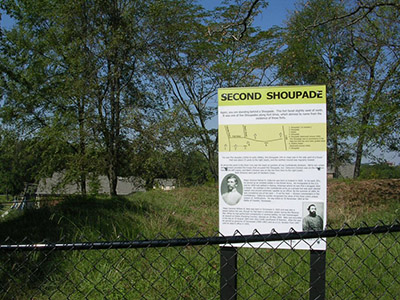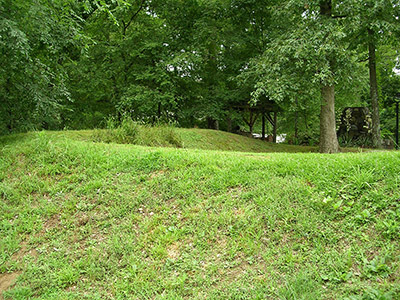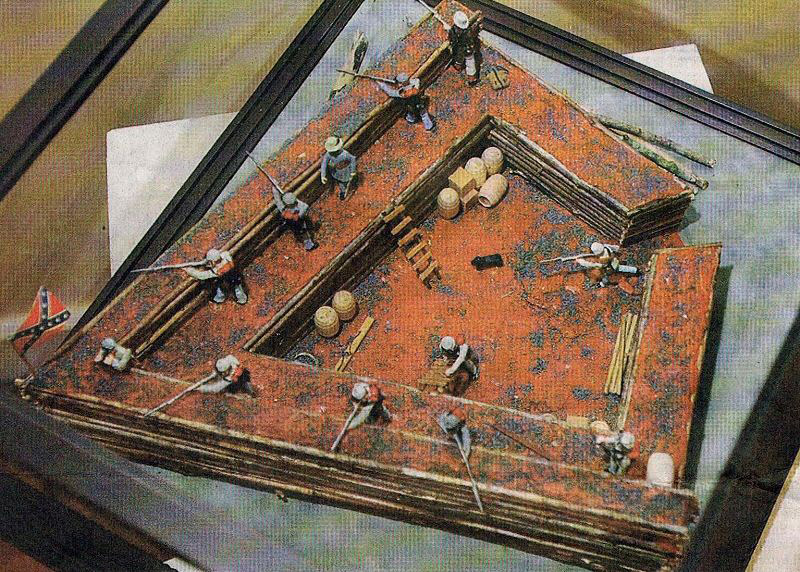 |
The Shoupade Story |
 |
|
|
|
William R. Scaife's scale model of a Shoupade, as it appeared in the Atlanta Journal-Constitution on July 18, 2005 |
|
|
Shoup loudly proclaimed that he had "aristocratic inclinations and admiration for the South" and, shocking his friends and colleagues, moved to Florida to fight for the Confederacy. The Governor of Florida commissioned Shoup as a Lieutenant, and he spent time at St. Augustine, studying the Castillo de San Marcos, whose corner bastions are credited as being the inspiration for the Shoupade. Shoup served as an artillery officer in the Battle of Shiloh (April 6-7, 1862) under General William Hardee (1815-1873). Captured at the Battle of Vicksburg (May 18-July 4, 1863), Shoup was paroled in time to participate in the defense of Atlanta. On June 18, 1864, Shoup approached Confederate commanding General Joseph E. Johnston (1807-1891) and, anticipating that Johnston's fortifications at Kennesaw Mountain would eventually be outflanked or overrun, proposed that he prepare a defensive line along the Chattahoochee River at the town of Smyrna, to Atlanta's northeast. Shoup intended his fortified line to be defended by a small portion of the army, leaving the rest of the troops available to raise a rumpus elsewhere. Shoup devised a six mile long fortified line consisting of what were essentially 36 individual starfort bastions, arrayed along the north bank of the Chattahoochee River. Each designed to hold around 80 rifle-armed troops, these fortifications were arranged to funnel an attacking force towards strategically placed artillery Redans, each armed with two smoothbore 12-pounder Napoleon Guns or 5-inch Ordnance Rifles. In theory, once an attacker was directed by rifle fire towards the spaces between the Shoupades, they would expose themselves to the cannon at the Redans, which would cleanse the field of breathing Yankees. |
|

A violently shadowed drawing of the Shoupade-Redan relationship, from one of the historical markers at Shoupade Park. Click on it, it's bigger than that. |
 |
Shoup's line of fortifications, which became known as Johnston's River Line, was built in late June and early July of 1864 by some 1000 slaves who had been commandeered from local plantations. Once completed, the line was visited by Confederate Major General Gustavas Woodson Smith (1821-1896), who said that this revolutionary design would make Shoup famous, and named the little pointy fortlets Shoupades. |
|
Sherman's March to the Sea, up to this point, had primarily been a stellar exercise in flanking maneuvers. Johnston would set up a defensive line, Sherman would outflank it, and the Confederates would fall back to the next line, a little closer to Atlanta each time. Union Major General William Tecumseh Sherman (1820-1891), after whom this march was named, deviated from this pattern only once, at Johnston's Kennesaw Mountain Line.
Much to the Union's misfortune. Though the Confederate positions on Kennesaw Mountain were eventually outflanked, it came after a frontal assault on those lines at the Battle of Kennesaw Mountain (June 27, 1864), at the cost of 3,000 Federal soldiers and 1,000 Confederates.
|
|
When Confederate troops were first sent to man the Shoupades on July 4, 1864, they were taken aback by these unusual structures. Troops actually began disassembling some of the Shoupades, intending to use the materials to build a proper fortified line. This behavior was stopped by Major General Patrick Cleburne (1828-1864), who proclaimed the works to be excellent.
Sherman saw the Johnston River Line for the first time on the morning of July 5, later writing that they were "the best line of field intrenchments I have ever seen." Still smarting from ordering the unnecessary frontal assault at Kennesaw Mountain, Sherman returned to the tried and true flanking maneuver. By July 8 he had found a way to cross the Chattahoochee River, upstream of the Johnston Line, and the Confederates, their flank now insecure, withdrew from the Shoupades. A week later, Confederate president Jefferson Davis (1807-1889) relieved Johnston of command.
|  |

Today there are remains of only nine of the original 36 Shoupades, of which a mere two are available to the public at Shoupade Park. |
|

The remains of a Shoupade that today exists in the side yard of a house built in the 1950's. This single house is scheduled to be replaced by eight houses, and it seems unlikely that the Shoupade will survive the transition. |
 |
Shoupades were essentially three log walls with dirt strategically packed inside. As such, those that remain exist as indistinct mounds of earth, the fate of virtually all unrestored Civil War field fortifications. Starforts didn't fare particularly well during the US Civil War. The ones that figured at all in that war were mostly built in the post-War of 1812 enthusiasm for US seacoast defense. Recently-completed forts thought to be impregnable, such as Fort Sumter, Fort Pulaski and Fort Macon, were proven to be distinctly pregnable to modern artillery, guns that were beyond imagination 30 years previously, when the forts had been designed. The front line was fluid, and as such virtually all of the fortifications built during the war were temporary by intent...and thus are today the aforementioned unsatisfying little mounds. Thanks to a huge amount of housing and commercial development on the north bank of the Chattahoochee at Smyrna, many of the remaining Shoupades have been bulldozed. The remains of nine Shoupades still exist today, and only two are available to the public. |
|
Ten thousand thanks to Georgia resident and Shoupade enthusiast Andrew Leuenberger, who alerted us to the starfortish entity of the Shoupade!
|
|
|




